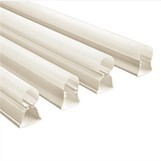Extruded lenses have emerged as a significant innovation in the field of optics, offering unique properties and cost - effective solutions. As a supplier of extruded lenses, I am often asked whether these lenses can be used in optical instruments. In this blog post, I will explore the feasibility, advantages, and limitations of using extruded lenses in optical instruments.
What are Extruded Lenses?
Extruded lenses are manufactured through an extrusion process, which involves forcing a molten plastic material through a die to create a continuous shape. This process allows for the production of lenses with consistent cross - sections over long lengths. The most common materials used for extruded lenses are polycarbonate (PC) and acrylic (PMMA), which offer good optical clarity, impact resistance, and ease of processing.
Feasibility of Using Extruded Lenses in Optical Instruments
The use of extruded lenses in optical instruments is indeed feasible. Many optical instruments, such as projectors, cameras, and spectrometers, require lenses with specific optical properties. Extruded lenses can be designed to meet these requirements. For example, they can be engineered to have a specific focal length, refractive index, and dispersion characteristics.
One of the key advantages of extruded lenses is their ability to be produced in large quantities at a relatively low cost. This makes them an attractive option for mass - produced optical instruments. Additionally, the extrusion process allows for the creation of complex lens geometries that may be difficult or expensive to achieve using traditional lens manufacturing methods.
Advantages of Extruded Lenses in Optical Instruments
- Cost - effectiveness: As mentioned earlier, the extrusion process is highly efficient and can produce lenses at a lower cost compared to other manufacturing methods. This cost advantage can be passed on to the manufacturers of optical instruments, making their products more affordable for consumers.
- Customizability: Extruded lenses can be customized to meet the specific needs of different optical instruments. For example, they can be made in different shapes, sizes, and optical properties. This flexibility allows for the design of optical systems that are optimized for specific applications.
- Lightweight: Materials like polycarbonate and acrylic used in extruded lenses are lightweight compared to glass lenses. This is particularly beneficial in portable optical instruments, where weight is a critical factor.
- Impact resistance: Polycarbonate extruded lenses have excellent impact resistance, making them suitable for use in optical instruments that may be subject to rough handling or vibrations.
Specific Applications of Extruded Lenses in Optical Instruments
- Projectors: Extruded lenses can be used in projectors to focus and distribute light evenly. Extruded Linear Lens can be designed to have a specific curvature that helps in shaping the light beam, resulting in a sharper and more uniform image projection.
- LED Lighting: In LED lighting systems, LED Light Lens are used to control the direction and distribution of light. Extruded lenses can be customized to provide different lighting patterns, such as spotlights or floodlights, making them ideal for a variety of LED lighting applications.
- Spectrometers: Extruded lenses can be used in spectrometers to focus light onto the detector. Their ability to be precisely engineered allows for accurate light collection and analysis, which is crucial in spectroscopic measurements.
Limitations of Extruded Lenses in Optical Instruments
- Optical quality: While extruded lenses can achieve good optical properties, they may not have the same level of optical quality as high - precision glass lenses. For applications that require extremely high resolution and low aberration, such as high - end microscopy or astronomy, glass lenses may still be the preferred choice.
- Temperature sensitivity: The optical properties of plastic extruded lenses can be more sensitive to temperature changes compared to glass lenses. This can cause variations in focal length and refractive index, which may affect the performance of the optical instrument.
- Surface finish: Achieving a perfect surface finish on extruded lenses can be challenging. Minor surface imperfections may scatter light, reducing the overall optical efficiency of the lens.
Overcoming the Limitations
Despite the limitations, there are ways to overcome them. For example, advanced coating technologies can be applied to extruded lenses to improve their optical quality and reduce surface scattering. Additionally, thermal management systems can be incorporated into the optical instrument design to minimize the effects of temperature variations on the lens performance.


The Future of Extruded Lenses in Optical Instruments
The future looks promising for extruded lenses in optical instruments. With continued advancements in materials science and manufacturing technology, the optical quality of extruded lenses is expected to improve further. New materials with better optical and thermal properties are being developed, which will expand the range of applications for extruded lenses in optical instruments.
Contact for Procurement
If you are interested in exploring the use of extruded lenses in your optical instruments, I encourage you to reach out to discuss your specific requirements. As a supplier of extruded lenses, I can provide you with high - quality products and customized solutions to meet your needs. Whether you are looking for Extruded Linear Lens, LED Light Lens, or Lampshade PC Diffuser, I am here to assist you.
References
- Smith, J. (2018). "Advances in Plastic Lens Manufacturing". Journal of Optics, 45(2), 123 - 135.
- Johnson, A. (2019). "Optical Properties of Extruded Polycarbonate Lenses". Proceedings of the International Optical Society Conference, 345 - 352.
- Brown, C. (2020). "Applications of Extruded Lenses in LED Lighting Systems". Lighting Technology Review, 56(3), 78 - 89.




